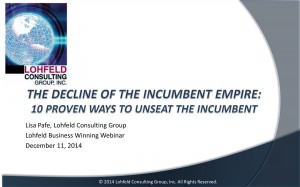Q&A Part 4 from The end of the incumbent empire – 10 ways to unseat the incumbent
In the past several years, incumbents have lost their advantage in the Federal Government market. Industry studies show that incumbent contractors now have approximately the same win rate on rebids as non-incumbents. Rapid technological change, as well as fiscal constraints, mean that customers are more willing to consider alternatives. Still, winning a bid against an incumbent contractor is a challenge because best informed wins, and the incumbent is still the best informed.
In this webinar, Lisa Pafe, CPP APMP and Lohfeld Consulting Group Principal Consultant, provides 10 proven best practices to create a competitive edge over the incumbent in today’s changing environment.
Click to watch the webinar replay and download the presentation and research brief.
(Look for Part 2 of The End of the Incumbent Empire: Remaining as Incumbent in the next couple of months.)
Here is Part 4 of the questions we received during the webinar with answers from Lisa Pafe.
Q: What usually drives the desire to change the incumbent contractor? What signs should a contractor look for as harbingers of likely changes with an incumbent?
A: Perceived inefficiencies, high prices, lack of innovation, high staff turnover, lack of technical skillsets, and lack of responsiveness are among the many drivers of change. Harbingers of likely change include a customer that is very open to meeting with challengers, conducts extensive market research, and changes the work scope and/or level of effort.
Q: What one thing irritates evaluators the most about incumbents’ proposals?
A: The one thing that irritates evaluators most is to repeatedly state that you are the incumbent rather than proposing a thoughtful solution.
Q: What are the questions you should NOT ask the customer? Said another way, are there dumb questions that can effectively knock you out of consideration, or that give away too much to your competition?
A: Instead of asking the customer what you can do to help them, suggest solutions and listen to their reaction. Ask very specific questions that require them to answer with examples. By moving from general to specific questions, you generate a higher level of engagement and more thoughtful and detailed responses necessary to gain the insight you are hoping for from a customer.
Q: What is the best way to gauge your percent chance of winning against an incumbent?
A: Use a SWOT analysis to generate a better understanding of strengths and weaknesses versus the incumbent and other competitors. If strengths far outweigh weaknesses, and you have a plan to mitigate your weaknesses prior to RFP release, the win probability increases. Another method is to identify and then assess progress towards key performance indicators for successful capture.
Q: What is the best way to gain access to an incumbent client when they don’t want to meet with anybody?
A: The best way to gain access is by conducting a listening campaign—meeting with a variety of customer stakeholders (remember, there is more than one customer) to suggest solutions, listening to their responses, and then shaping your solution accordingly. You can also gather information by researching and then connecting with current and former employees and contractors using LinkedIn, Web searches, and customer/incumbent websites. The customer will have incentive to level the playing field if they like the solutions you are offering during capture.
Q: When a government agency publishing a solicitation has a preferred vendor in mind prior to releasing the solicitation, what is the best means of capturing the proposal evaluators’ attention so that they give my company’s proposal an open-minded evaluation?
A: You can differentiate yourself by proposing better and/or more strengths that benefit the customer by exceeding requirements, helping meet contract or mission requirements, and/or offering value-add. You make an impression by positioning your strengths with the customer during the capture phase. The best method to use in crafting your solution is focusing on building the greatest number of strengths and mitigating all weaknesses prior to RFP release. The number one must do is to position and shape your value proposition by listening to the customer. In an LPTA procurement, the biggest factor other than cost is past performance.
Q: You mention that 50% of incumbents are losing in the federal world. Do you have a statistic about incumbents in the commercial world?
A: No, unfortunately it is much harder to gather information about the commercial market because contract awards are not publicly available.
Q: Whom do you recommend hiring as a Price to Win Analyst?
A: Lohfeld Consulting offers this service. You can find further information here: https://www.lohfeldconsulting.com/service/go-to-market-strategy-and-execution.
Paperback or Kindle
10 steps to creating high-scoring proposals
by Bob Lohfeld
contributors Edited by Beth Wingate
Subscribe to our free ebrief
Teaming friends, frenemies, and enemies—12 tips to mitigate harmful effects
Did you know that contracting officers spend up to 20% of their time mitigating disputes between teaming partners? In an informal poll we conducted on LinkedIn last month, 40% of respondents classified their teaming partners as “frenemies” on their last bid.
Explore Further
- Advice (445)
- AI (5)
- APMP (17)
- Business Development (197)
- Capture Management (196)
- Favorite Books (5)
- Go-to-Market (27)
- Graphics (6)
- Lohfeld Books (3)
- Past Performance (58)
- Post-submission Phase (15)
- Pre-RFP Preparation (210)
- Proposal Management (269)
- Proposal Production (60)
- Proposal Reviews (27)
- Proposal Writing (77)
- Pursuit Phase (89)
- Research Report (2)
- Resources (60)
- Tools & Tips (258)
- Training (10)
- Uncategorized (220)

Sign Up for INSIGHTS and Download your FREE book
We'd love to help you with your proposals. Enjoy our complimentary Lohfeld Consulting Group Capture & Proposal Insights & Tips book with your FREE subscription to our Insights Newsletter.
GET YOUR FREE BOOK





